(Written by William)
Ever since the #10199 LEGO Winter Village Toy Shop was released in 2009, I’ve been enamored with the LEGO Winter Village seasonal series. In more recent years, we got the #10254 LEGO Winter Holiday Train in 2016, the #10259 LEGO Winter Village Train Station in 2017, and the #10263 LEGO Winter Village Fire Station for this year’s holiday season. The Winter Village Fire Station comes with a ladder truck, an ice rink, a bench with lamppost, and a Christmas tree. 🙂
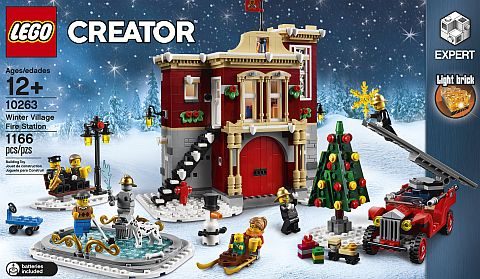
If this is your first LEGO Winter Village set, having all those additional scenes and accessories is welcome, however, if you have been collecting the LEGO Winter Village series for a long time, it may start to feel like your village is getting overcrowded with Christmas trees, benches, and lampposts. It’s not easy to keep both new fans and old time collectors happy, and in general, the LEGO Winter Village sets are well balanced, but I also noticed a bit of fatigue and predictability with this most recent set.
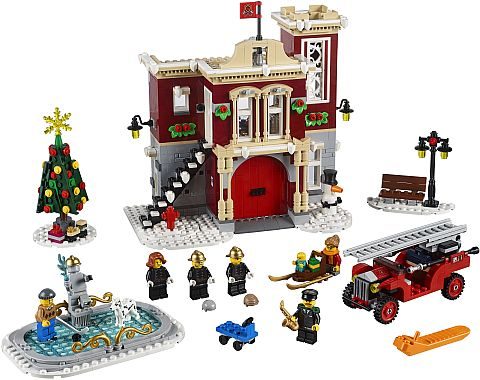
The #10263 LEGO Winter Village Fire Station is filled with a great selection of minifigures, including three firefighters, an ice hockey player, a musician with saxophone, a girl with scarf, and a baby with moose sweater (exclusive to this set). The characters are rounded out with a brick-built snowman and a Dalmatian. I consider the musician the fire chief, who plays the saxophone as a hobby, giving him some extra personality.

And that’s what’s always been the hallmark of the LEGO Winter Village sets, their personality. While the #10263 LEGO Winter Village Fire Station may not stand out as the most creative amongst the LEGO Winter Village sets, it is one of the few LEGO fire stations I can think of that focuses a bit more on the homey quality of the building. The others are the #10197 LEGO Creator Fire Brigade from 2009, and the #75827 LEGO Ghostbusters Firehouse HQ (which is not even used as a fire station).
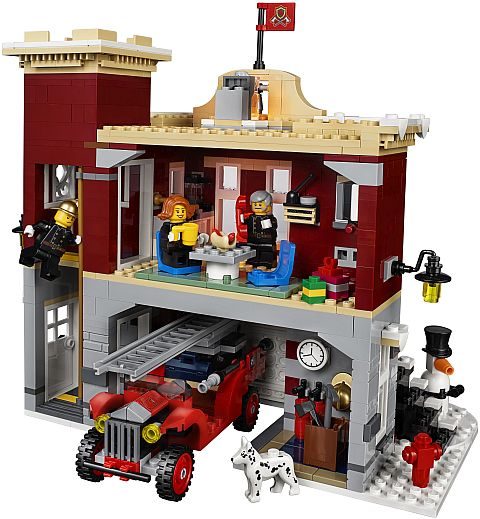
Personality aside, the other draw to the LEGO Winter Village sets is they manage to give us a fulfilling building experience for a moderate price. They are what I’d consider the very simplest LEGO Creator Expert Builder sets. In other words, they look intricately built and include some advanced building techniques, but shouldn’t prove too difficult to put together. Below, we will look at some of the interesting techniques I found while building it.
➡ DATING YOUR BUILDING STYLE WITH LEGO
One key feature of every LEGO Winter Village set to date is the charming old world style. This comes across in the buildings’ architecture, style of vehicles, and ornate elements we don’t normally see in a more modern setting. In addition, LEGO designers add something a bit more subtle from time to time, which, in this case, can be seen in the fire truck.
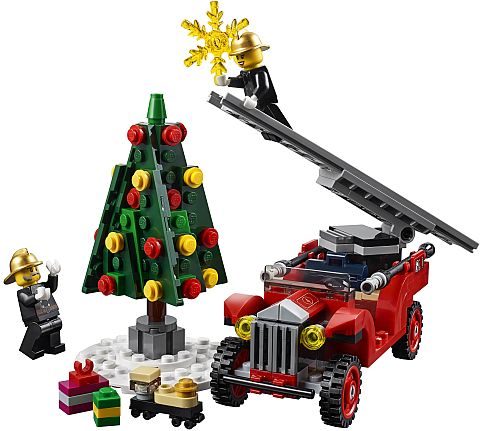
Among its fancy curves, the truck has a surprisingly simple design. And that is a technique in itself that I would like to point out. LEGO sets from the past often used a simpler and more straightforward building style. This approach doesn’t do much for stunning realism, but it does carry a charm all its own. Older LEGO fans can feel a sense of nostalgia as they build a simply designed vehicle that reminds them of their childhood.

And, in the case of the fire truck, LEGO designers didn’t stop there in dating their building style. They also used pieces that are commonly associated with older sets, like the ladder and hoses. These are the types of pieces we’d see on a regular basis in the late 80’s and early 90’s. Although they are still used from time to time these days, they aren’t as common. Prominently featuring these much older elements gives fans a direct connection to their past. If your goal is creating nostalgia and a connection to the past, I highly recommend studying these techniques as they can have a real powerful effect on your audience. Good places to start is simplifying your design, and featuring iconic old pieces that older LEGO fans will instantly recognize.
➡ CLIPPING SIDEWAYS WALLS WITH LEGO
Not too long ago, I was working on the corner of a building that required some sideways walls. I had gotten a bit fixated on this technique after seeing it in a few of the LEGO Modular Buildings. The problem I ran into was that the result of what I built was rather structurally weak. I did make allowances so my model won’t fall apart, but I wasn’t thrilled with how easily it could break.

I was delighted to discover that the #10263 LEGO Winter Village Fire Station showed me exactly what I needed to do to fix my issue. On the second floor of the building, behind the snowman, are two ornate sideways-built windows. Each is connected to some sideways studs and sort of meet in one corner. The odd thing is, where they meet, they don’t attach to those bricks. Instead, the walls are clipped together and then angled to form a ninety-degree corner. This simple but elegant solution solved the problem I was having with my own walls. Generally, you have to add a tile to whatever is built sideways just so you don’t have to figure out what to do with unwanted studs. The problem is that this leaves no connection-point, which results in structural weakness. By clipping the walls together, you end up reinforcing that corner making it a rather strong design. Another great feature of this technique is that that clips and bars are hidden inside the angle of the walls. And, even if the positioning of the clips and bars was a problem for some, it wouldn’t be too hard to build off the bars to hide them.
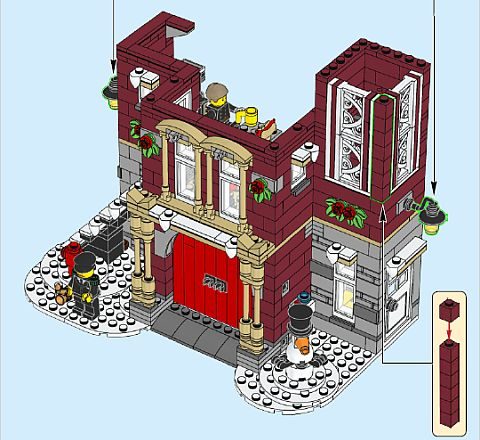
➡ THE CEILING FACTOR WITH LEGO
One interesting feature of the #10263 LEGO Winter Village Fire Station is just how large it is compared to the other LEGO Winter Village sets. This is made possible by the large garage space left inside the station. The section has no floor and opens up to the big double doors. This is a smart use of parts, or, in this case, lack of parts; you end up with a much larger building without too much effort. So, what to look out for when designing a large empty space? Simple; base it on how well you can make the ceiling.

Contractors who build real-life houses will tell you that what holds a building together is the roof. The walls and flooring play their own part, but it’s the roof’s job to tie all the pieces together. The same principle can be applied to a LEGO model; the more walls a single plate can tie together, the stronger the ceiling will be. LEGO designers do cheat a bit here by making the topmost roof detachable. What that means is then the floors in between have to be fairly solid, similar to what we see in the LEGO Modular Buildings. Even with detachable features though, each floor or roof connects in with the walls to make everything nice and sturdy.
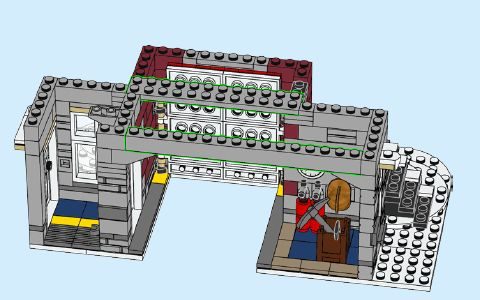
The first floor is built in roughly two sections, which are connected together in five places; top and bottom of the door, a strut in the center, and a long brick in back. These are all weak on their own, but also provide an interesting feature. Every strut acts as an extension to the walls they are attached to. This means that by connecting walls together they can now lend support to each other. Think of it as if the strut is forming a doorway in the wall. The downside of this technique is that it will only be as strong as the strut you use.

Put in a different way, if you add a plate on the left side of the building to reinforce the beam, it stretches all they way to the right side, thus indirectly strengthening the right side of the building as well. This stems from the very basic concept of interlocking bricks. Where we run into problems is when we must go beyond the length of a single piece. Patching the ceiling in sections is fine, but you might end up with sagging and weak points if the beams that hold up the ceiling are piecemealed together. You could work around this by using LEGO Technic bricks and pinks to build a stronger crossbeam. Unlike regular LEGO elements, LEGO Technic excels at building lengthwise structures that have a good deal of strength. In this set though, LEGO designers limited themselves to how far parts can naturally stretch.
➡ APPLYING WHAT YOU LEARN
Intentionally dating your building style can add character and uniqueness to your LEGO models. Here, we covered two ways to achieve this; choosing building techniques and choosing pieces specific to an era. By building simpler and using older pieces, you can easily get the sense of an older style. The drawback is that this leans a bit away from ultra-realistic, but the technique can still be useful at times.
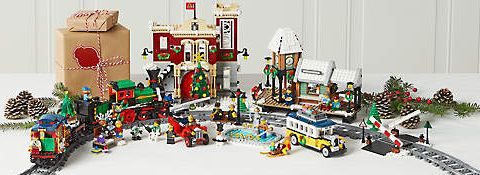
The sheer usefulness of the wall clipping technique definitely makes it a building method worth studying. Knowing how the spacing works for making clips attach can make very intricate designs much more stable. The last technique we discussed about ceilings is also very useful, as it can help you define how big you can make an empty space inside a building. I’ve built some really odd buildings in the past and it always comes down to solving how to build the ceiling. If the ceiling can be made strong then the rest is just simple walls.

What do you think? How do you like the #10263 LEGO Winter Village Fire Station? And what do you think of the techniques we discussed here? Have you used any of them in your own models? If you built this set already, did you notice any other techniques that you found interesting? Feel free to share and discuss in the comment section below! 😉
And you might also like to check out the following related posts:












Those are some useful techniques. Lego has been making some very long plates and bricks (I think the longest is 16 studs?), so you can reach over some fairly large gaps. And as you said, you can always use Technic if regular bricks don’t work.
I’m going to have to study that wall clipping thing, as I could see that being useful to transition from sideways building to upwards building. Clips and bars really made a big difference for Lego.
I think this building is a little too plain compared to the other Winter Village buildings. And the style is different too. I can’t explain it exactly why, but it doesn’t seem to fit in with the others that well.
Honestly I kind of feel the same way.
I think it has a lot to do with its relatively blocky look. Most of the other Winter Village sets have elegantly sloping roves and elaborate decorations built into the architecture.
This is more or less a rather plain box of a building. Problem is fire stations are mostly built as plain box buildings. You really don’t get anything exciting until you have a really large fire station, which this set tried to do, but it seems hampered by still being relatively small compared to other Expert sets.
I think if they had played with more intricate brickwork on the building it might have popped a bit better.
When I first saw this model I was pretty much expecting an outcry of ‘Not another fire house?!’ as it’s a very popular theme with Lego. 😉
I just bought a solid white Ikea table top that I’ll be putting over my coffee table to place my Winter Village on. I’m really quite limited for space, so I figure from this point on I’ll only be buying the holiday models I really gotta have. So just for my personal tastes I’ll be passing on the fire house. It’s very charming, but… yeah. Hard to pass up any model since I have all of the others, (minus the new train, but I have the first holiday train, so I’m good there.) but space is limited.
Ah, the challenges of a collector. 😉
Yeah, this set does no one any favors when it comes to space.
It’s almost big for big sake which means it sacrifices detail work it probably could have really used.
Now you may be able to squeeze in a bit more space by not putting out all the different lampposts and benches. And of course trees, since so many of the sets created one. Just use the ones you like the best.
Personally, I’m still rooting for a Winter Village Hardware Store. ;D
The fire station is an important part of Christmas tradition. They are often decorated festively, and they when Christmas trees were decorated with real candles, they often had to put out fires. So, I’m glad lego added a fire station to the village!
You know, that is one of the biggest redeeming qualities of this set. And it’s probably why there wasn’t an outcry from fans.
We really didn’t have a Winter Village version and sure it may not be the best looking building in town, but it is something that sort of completes the town in a way few other choices would.